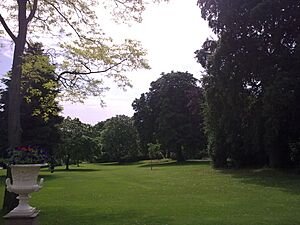Sheffield Botanical Gardens facts for kids
Quick facts for kids Sheffield Botanical Gardens |
|
|---|---|

The Glass Houses, Sheffield Botanical Gardens
|
|
| Lua error in Module:Location_map at line 420: attempt to index field 'wikibase' (a nil value). | |
| Type | botanical garden |
| Location | Ecclesall Road in City of Sheffield, South Yorkshire, England |
| Area | 19 acres (7.7 ha) |
| Created | 1836 |
The Sheffield Botanical Gardens are amazing botanical gardens located near Ecclesall Road in Sheffield, England. These gardens are like a giant outdoor museum for plants! They are home to about 5,000 different kinds of plants, spread across 19 acres of land. That's a lot of plants to explore!
The gardens were designed by a talented person named Robert Marnock. They first opened their doors to visitors in 1836.
Contents
Exploring the Gardens
The Sheffield Botanical Gardens have many cool things to see.
Glass Pavilions
One of the most famous parts of the gardens are the beautiful glass buildings called the glass pavilions. These are very old and important buildings, listed as Grade II* (which means they are special and protected). They were carefully fixed up and reopened in 2003, looking as grand as ever. Inside, you can find plants that need a warm, protected environment to grow.
Other Interesting Spots
As you walk around, you'll also see:
- The main gateway where you enter.
- The south entrance lodge, another historic building.
- A special area called a bear pit. Don't worry, there are no real bears there now! Instead, you'll find an 8-foot-tall steel statue of an American Black Bear. His name is Robert the Bear, and he's a fun sight to see.
History of the Gardens
The idea for the gardens started in 1833 when the Sheffield Botanical and Horticultural Society was formed. They wanted to create a beautiful place for plants and people.
How the Gardens Began
To get enough money, the society sold shares to people. By 1834, they had raised £7,500. This money helped them buy 18 acres of sunny farmland from a local businessman named Joseph Wilson.
When the gardens first opened in the summer of 1836, they were very popular! About 12,000 people came to visit.
Becoming Free for Everyone
Later, as the 1800s were ending, a group called Sheffield's Town Trust took over managing the gardens. They bought back the shares from the original owners. The best part? The Trust decided to stop charging an entry fee. Since then, it has been completely free to visit the Sheffield Botanical Gardens!
Even though the Town Trust still owns the gardens, the Sheffield Corporation (which is like the city council) signed a long lease in 1951. This means the city now helps manage the gardens day-to-day.
Special Plant Collections
The Sheffield Botanical Gardens are not just pretty; they are also important for plant science. They hold special "national collections" of certain plants. This means they are responsible for growing and looking after many different types of these plants.
The gardens have national collections of:
- Sarcococca (also known as sweet box)
- Weigela (a type of flowering shrub)
- Diervilla (a plant closely related to Weigela)
These collections help experts study and protect these plant families.
Images for kids
See also
 In Spanish: Jardín botánico de Sheffield para niños
In Spanish: Jardín botánico de Sheffield para niños






